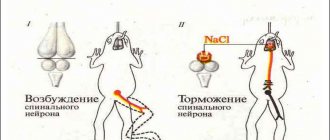From a psychological point of view, communication is a complex process within which 3 aspects can be distinguished, or, as they are called, 3 sides of communication:
- Communicative. It is the exchange of information, facts, points of view and judgments carried out through oral and written speech, gestures, signs and other communication mechanisms.
- Perceptual. At this level, people form perceptions of each other based on their behavior and communication. Of great importance is the appearance of the interlocutor, attractiveness and solidity, facial expressions and gestures.
- Interactive. These are various forms of interaction between people that arise in the process of their joint activities.
Today we will look in detail at what the interactive side of communication is. We will look at its structure and basic principles, find out what types of interactions relate to it, and also consider the main factors that influence it.
What is the interactive side of communication?
The interactive side of communication is a conditional group of elements of communication, which includes various forms of interaction between individuals when they carry out joint activities. That is, this includes the various actions by which they influence each other, but does not include the exchange of information or emotions.
The structure of the interactive side of communication includes the following elements:
- subjects of interaction – individuals participating in the process;
- interconnection – relationships by which subjects are connected with each other;
- interaction – the influence that subjects have on each other;
- consequence – the consequences of interaction for each of the subjects.
One of the most famous researchers of the interactive side of interaction is the American psychologist Herbert Mead, the creator of the concept of symbolic interactionism. He owns the statement that a person most effectively develops and recognizes himself through interaction with others through joint activities.
Herbert Mead believed that a person can best realize his potential for development only through active interaction with those from whom he can learn something. Ordinary observation of successful people and attempts to imitate them will bring much less benefit.
Interactive communication plays a huge role in the process of socialization, as well as in the further development and realization of personality. In addition, it contributes to the formation of stable social connections. In particular, our friends, comrades and acquaintances are most often those people with whom we have become close by engaging in some kind of joint activity.
Communicative
Most often, when people talk about communication, they mean precisely its communicative side.
In this case, we are talking about the exchange of information between subjects of social relations.
People share their thoughts, plans, ideas, views with each other. Based on the information received, relationships are built and activities are organized.
Communication should be viewed as more than just an endless flow and reception of information. All parties to the process take an active position and strive to understand the information provided to them.
The quality of contact is determined by the level of perception of information, its acceptance and understanding.
If one subject constantly puts forward his ideas and views, and the second does not perceive or even understand them, then there is no need to talk about effective communication in this case.
The communication side is a way of psychologically influencing an opponent. During the transfer of information, one person influences another. The more developed a subject’s communication skills are, the higher the level of influence he has on his interlocutors.
Successful speakers, political and ideological leaders are, first of all, people with excellent communication skills.
The ability to influence others through speech allows such individuals to gain a certain position in society.
Information is provided on two levels:
- Incentive. These are remarks of an ordering, pleading, recommendatory nature. They are expressed with the aim of stimulating a person to perform some action.
- Stater. This is a notification speech, which is aimed at providing some information. Ranges from indifferent presentation to active persuasion.
It should be taken into account that even among representatives of the same language group, misunderstandings may arise during the exchange of information. That is, the same information is evaluated differently.
This is explained by the influence of a number of factors: age, social status, intellectual abilities, emotional mood, etc.
Thus, a child and an adult perceive the same news at completely different levels due to age-related characteristics of the psyche and intellect.
Communications occur at the interpersonal level (between spouses, friends, colleagues, relatives), and at the group level. For example, during breakfast on a weekend, a husband and wife exchange ideas for leisure activities.
One participant in the contact expresses his thoughts and ideas, and the second listens to him.
Periodically they change roles.
As a result, effective interaction is built, each participant of which has the opportunity not only to express his opinion, but also to obtain the necessary information from his opponent.
An example of group communication is a teacher teaching a lesson in a classroom. During the lesson, the teacher who has the information shares it with his students.
At the same time, children have the opportunity not only to perceive incoming information, but also to ask clarifying questions and express their thoughts. This communication is effective and efficient.
At the same time, another teacher may provide children with information from a perspective that is completely incomprehensible to them. At the same time, students do not have the opportunity to ask questions, express their opinions, or clarify the information received.
In such a situation, the flow of information passes by the subjects to whom it was directed. The communication process turns out to be ineffective.
Examples from life
To fully understand the interactive side of communication, let’s consider several situations that arise in everyday life and highlight the interactive side of communication in them.
As an example, consider communication with a salesperson in a store. First, you greet and smile at each other - this is the perceptual side, during which you tune in to communicate, exchanging emotions. Next, you list the goods, and the seller names the final cost - this is the communication part. After that, you pay, and the seller gives you the goods and helps you put them in a bag - this is the interactive side of your interaction.
Let's take another example - a man is going on a date. When he meets a girl, he smiles at her when he meets her - this is the perceptual side. When a man and a woman discuss where they will go today, this is the communicative side. When they ride the carousel, eat ice cream, and shoot at the air rifle range, that's the interactive side of things.
Types of interactions
Let's consider what types of interactions can develop between participants within the interactive side of communication. All possible interaction options can be divided into two categories:
- Cooperation. These are coordinated actions of two or more entities aimed at achieving a result beneficial to all parties.
- Competition. This is an interaction built on confrontation, in which each subject strives to achieve a result that is beneficial to him, but not beneficial to others.
In addition, psychologists identify several interaction strategies:
- Cooperation. This is pure manifestation of cooperation. All participants in the interaction strive for the same goal, so their actions are aimed at achieving a mutually beneficial result.
- Opposition. This is pure competition. Each participant focuses exclusively on his own goals and does not take into account the interests of other entities. Accordingly, his actions are beneficial to himself, but disadvantageous to others.
- Compromise. This strategy implies that the goals of the subjects are initially different, but they agree to act together to partially (and conditionally equal) satisfy the interests of all participants.
- Compliance. This strategy involves one participant sacrificing his own interests to help his partner achieve his goals.
- Avoidance. This strategy consists of one participant sabotaging the interaction and sacrificing his own interests only to prevent the other participant from achieving his goals (such situations are sometimes described by the saying “To spite my mother I’ll freeze my ears”).
Interaction in psychology
A person can communicate linearly without entering into relationships with other people. More often you have to resort to two-way contact, without which it is impossible to perform most of your functions.
In psychology, interactive communication is defined as interaction through words and actions. The joint influence of process participants helps to develop the personal qualities of subjects united by common tasks and goals in achieving the final result.
Additional Information. Such a concept as interaction presupposes the main meaning of communication in joint organized activities in which information, ideas, skills, and knowledge are exchanged.
Family, teaching (student) and work teams, the service sector, leisure - everywhere a person has to exchange actions and words, since people are dependent on each other. Whether the communication turns out to be friendly or not depends on the positions of the participants in the process, their moods and the current situation.
Interactive communication option
For interaction to take place, a combination of 3 components is necessary:
- the presence of subjects of communication, these can be either 2 interlocutors or a whole team;
- the subject of the action regarding which mutual communication is carried out;
- mechanism for regulating relations.
Interaction can be designated as effective if the positions of those communicating coincide and are aimed at achieving the same goal. At the same time, participants in the action must adequately assess the situation and behavior styles.
Principles of interactive communication
This component of interpersonal interaction may not seem as important as the informational one. However, its importance cannot be underestimated. In particular, it is thanks to it that the socialization of the individual occurs, as well as its further development and improvement.
The interactive side of communication is subject to the following principles:
- presence of goals and motives for interaction;
- availability of necessary space and time;
- coordination of actions;
- agreement on certain rules of behavior;
- exchange of additional information in the process.
The presence of these features is characteristic of all types of interactive interaction, although they can manifest themselves in different ways.
Factors influencing the contact process
For interaction to be productive, certain circumstances are required. Basic prerequisites include:
- awareness of human needs (one’s own and those of participants in interaction);
- the ability to create motives, strengthen them, encouraging participants to take active action in the right direction;
- using various incentives to help increase motivation.
Factors supported by moral norms and universal rules will help avoid conflicts during the contact process and raise interactive communication to the maximum level.
Basic behavioral styles
American psychologist Eric Berne, the creator of transactional analysis, identified three main models of behavior in interactive interaction:
- Adult. A person who has chosen this model behaves judiciously, analyzes circumstances using logic and common sense, restrains emotions and other weaknesses.
- Child. This model implies emotional, infantile and often illogical behavior, as well as impulsive actions under the influence of momentary desires.
- Parent. A person who has chosen this model of behavior believes that he is the most intelligent, wise and responsible subject of interaction. He does not doubt for a second that he is right, and even if other participants act more rationally, their behavior seems stupid to him.
Each person can find himself in any of the listed roles, no matter what he thinks to himself. Obviously, the best option in any situation is the “adult” model, but not everyone is able to always behave rationally and judiciously. Therefore, everyone sometimes becomes “children”, obeying momentary desires, or “parents” who think that they are the most “adults” in this situation.
Roles of participants in interactive communication
Depending on the type of relationship, social and interpersonal roles can be considered. A social role is a pattern of behavior that an individual adheres to in order to meet the expectations of society. An interpersonal role is a model of behavior in personal relationships (leader, offended, neglected, idol, etc.).
Social roles are determined by such factors as:
- social status;
- profession or type of activity;
- sex and gender;
- marital status and role in the family (husband, wife, son, daughter).
Interpersonal roles are formed through interaction with other individuals through emotional and interactive communication.
Both social and interpersonal roles have two components :
- Role expectation is a set of situational expectations placed on an individual by society, those around him, and himself.
- Role performance is a pattern of behavior chosen in order to meet these expectations.
For optimal interactive interaction, it is important that both of these components are as consistent as possible with each other. Otherwise, interaction may turn into conflict , which will be very difficult to stop.
What does it depend on?
This is a component of communication that reflects direct interaction.
Such interaction always leads to some result.
Moreover, the result can be both positive and negative.
This aspect of communication largely depends on the social roles that are imposed on a person by society. So, a young woman can be at the same time a mother, wife, boss, daughter, friend, etc.
Each social role requires it to fulfill the obligations that these roles imply . So, as a mother of children, she attends parent-teacher meetings, matinees and events that take place at school and kindergarten.
She enters into cooperation with other parents to solve various organizational issues. As a wife , she performs household duties, solves household problems together with her husband, and interacts with his parents.
The role of the boss imposes obligations on her to build relationships with subordinates, coordinate the activities of the team, develop an effective work strategy, etc.
Compliance of behavior with social expectations is confirmed by numerous interactive interactions during which the individual performs the actions expected of him.
If during communication a person demonstrates socially unacceptable behavior, his interaction with others becomes more complicated .
Conflict
Conflict is a separate and very extensive form of interactive interaction between people. It is determined by the presence of opposing aspirations and goals among the participants. From a psychological point of view, conflict consists of such elements as:
- conflict situation;
- participants' positions;
- opponents (participants with opposite positions);
- object (what the conflict is built around);
- incident (the event that served as the occasion);
- development;
- permission.
All behavioral options that each party to the conflict can choose can be classified into one of five models:
- Competition (confrontation). This is an active defense of one’s interests using all available levers of influence. At the same time, the participant takes a tough position in relation to competitors, thereby recognizing that this is not just a dialogue, but a real conflict.
- Evasion (silence). If a participant in the conflict is not in the mood for reconciliation, but also does not particularly want to participate in the struggle, he tries to “step aside.” At the same time, he does not deny the existence of a conflict situation, but demonstrably demonstrates indifference to the object of the conflict.
- Device. This model implies that a participant in a conflict situation strives to maintain good relations with the opponent, therefore he carefully defends his point of view and makes concessions more easily.
- Cooperation (readiness for dialogue). Sometimes a participant in a conflict situation may initially strive for a compromise, so he willingly exchanges opinions with his opponent and does everything to find a solution that is beneficial to all parties.
- Compromise. This model implies joint actions aimed at achieving a result that will suit each of the parties (although it will not be perceived as ideal).
A conflict is a collision of parties, opinions, forces, opposing goals, interests, positions and views of opponents or subjects of interaction
Concept of strategy
The strategy of behavior in a conflict situation is:
- A way to pursue certain interests.
- A course of action to achieve goals.
- Communication style.
Stages of choosing a strategy
- Analysis of a conflict situation
- Assessing your own strengths and those of your opponent
- Clearly articulating your own goals
- Analysis of the opponent's actions and motives
- Deciding on the choice of strategy
Strategies (K. Thomas and R. Kilmann)
Rivalry (competition)
The goal is to obtain a one-sided win.
Conditions:
1. The presence of power and authority, which is recognized by the opponent.
2. Authoritarian management style.
3. A hopeless situation.
Rivalry - "Shark"
This is a focus on winning, regardless of one’s own victims or the damage caused to the opposing side. The preference for such behavior in conflict is often due to the desire to protect oneself from psychological trauma caused by a feeling of defeat. This strategy reflects a form of struggle in which one side emerges victorious.
The strategy of competition can be used by a person who has a strong will, sufficient authority, power, who is not very interested in cooperation with the other side and who seeks first of all to satisfy his own interests.
Evasion (escape)
The goal is to leave due to unwillingness to cooperate and communicate.
Conditions:
- The object of the conflict is unimportant.
- Lack of authority.
- Need for additional information.
- The opponent is a difficult person to communicate with.
Evasion - "Turtle"
It is usually implemented when the problem at hand is not so important to you, you do not defend your rights, do not cooperate with anyone to develop a solution and do not want to waste time and effort on solving it.
This style is also recommended in cases where one of the parties has more power or feels that he is in the wrong, or believes that there are no serious reasons for continuing contact.
Device
The goal is to get results with minimal effort.
Conditions:
1. The object of the conflict is unimportant.
2. The need to restore balance and stability.
3. Insufficient resources and power to solve the problem in your favor.
Device – “Teddy Bear”
This type of response is aimed at the maximum in relationships and the minimum in achieving personal goals. This is sacrificing one's own interests for the sake of the interests of another. This is an attitude of goodwill, of the desire not to hurt the feelings of another.
The accommodating style means that you work cooperatively with the other party, but do not try to defend your own interests in order to smooth the atmosphere and restore a normal working atmosphere. This style is believed to be most effective when the outcome of the case is extremely important to the other party and not very significant to you, or when you are sacrificing your own interests in favor of the other party.
Compromise
The goal is to obtain an “average” result through mutual concessions.
Conditions:
- Opponents have the same arguments and equal amount of power.
- The need to maintain a positive socio-psychological climate in the team.
- Making a temporary solution.
Compromise – “Fox”
This style means joint actions with another person, making concessions in one’s own interests so that the enemy does the same. Such people tend to propose a middle position, trying to find a combination of benefits and losses for both sides.
In this regard, it is somewhat reminiscent of the style of cooperation, but it is carried out on a more superficial level, since the parties are inferior to each other in some way.
Cooperation
The goal is to find the most acceptable solution for the parties and maximize gains.
Conditions:
- Decision approaches are important, and there is no room for compromise.
- Possession of equal power and authority.
- There are strong long-term relationships between opponents.
Cooperation – “Owl”
A person with this type of response openly acknowledges the conflict, presents his interests, expresses his position and suggests ways out of the conflict. When resolving a controversial situation, people with this type of reaction try to determine what all the interests and controversial issues involved are. At the same time, it expects reciprocal cooperation from the enemy.
This style is the most difficult, as it requires longer work. The purpose of its application is to develop a long-term mutually beneficial solution. This style requires the ability to explain your desires, listen to each other, and restrain your emotions.










